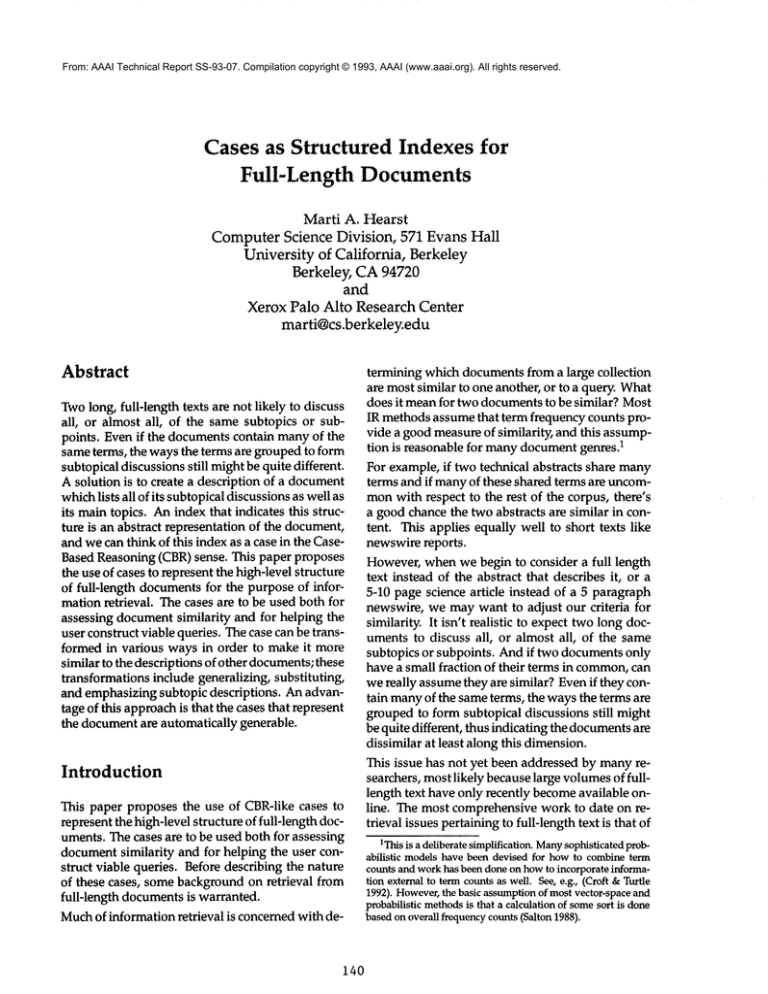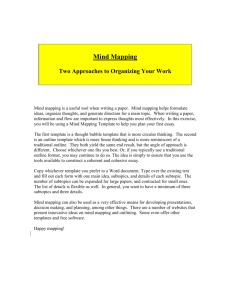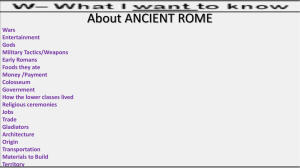
From: AAAI Technical Report SS-93-07. Compilation copyright © 1993, AAAI (www.aaai.org). All rights reserved.
Cases as Structured Indexes for
Full-Length Documents
Marti A. Hearst
Computer Science Division, 571 Evans Hall
University of California, Berkeley
Berkeley, CA 94720
and
Xerox Palo Alto Research Center
marti@cs.berkeley.edu
Abstract
termining whichdocumentsfrom a large collection
are mostsimilar to one another, or to a query. What
Twolong, full-length texts are not likely to discuss does it meanfor two documentsto be similar? Most
IR methodsassume that term frequency counts proall, or almost all, of the same subtopics or subvide a good measureof similarity, and this assumppoints. Even if the documentscontain manyof the
same terms, the ways the terms are groupedto form tion is reasonable for manydocumentgenresJ
subtopical discussionsstill mightbe quite different.
For example, if two technical abstracts share many
A solution is to create a description of a document terms and if manyof these shared terms are uncommonwith respect to the rest of the corpus, there’s
whichlists all of its subtopicaldiscussionsas well as
its maintopics. Anindex that indicates this struca goodchance the two abstracts are similar in conture is an abstract representation of the document, tent. This applies equally well to short texts like
and wecan think of this index as a case in the Case- newswirereports.
Based Reasoning (CBR)sense. This paper proposes
However,whenwe begin to consider a full length
the use of cases to represent the high-level structure
text instead of the abstract that describes it, or a
of full-length documentsfor the purpose of infor5-10 page science article instead of a 5 paragraph
mation retrieval. Thecases are to be used both for
newswire, we maywant to adjust our criteria for
assessing documentsimilarity and for helping the
similarity. It isn’t realistic to expecttwo long docuser construct viable queries. Thecase can be transumentsto discuss all, or almost all, of the same
formed in various ways in order to makeit more subtopics or subpoints. Andif two documentsonly
similar to the descriptions of other documents;these
have a small fraction of their terms in common,can
transformations include generalizing, substituting,
wereally assumethey are similar? Evenif they conand emphasizing subtopic descriptions. An advantain manyof the sameterms, the waysthe terms are
tage of this approachis that the cases that represent groupedto form subtopical discussions still might
the documentare automatically generable.
be quite different, thus indicating the documentsare
dissimilar at least along this dimension.
This issue has not yet been addressed by manyreIntroduction
searchers, mostlikely becauselarge volumesof fulllength text have only recently becomeavailable onThis paper proposes the use of CBR-like cases to
line. The most comprehensive work to date on rerepresent the high-level structure of full-length doc- trieval issues pertainingto full-length text is that of
uments. The cases are to be used both for assessing
1This is a deliberate simplification. Manysophisticated probdocumentsimilarity and for helping the user conabilistic models have been devised for how to combineterm
struct viable queries. Before describing the nature
counts and work has been done on howto incorporate informaof these cases, somebackgroundon retrieval from tion external to term counts as well. See, e.g., (Croft &Turtle
1992). However,the basic assumptionof most vector-space and
full-length documentsis warranted.
probabilistic methodsis that a calculation of somesort is done
Muchof information retrieval is concernedwith debased on overall frequencycounts (Salton 1988).
140
Salton and Buckley(Salton &Buckley1991b),(Salton
& Buckley 1991a), whotake pains to normalize the
lengths of the documentsthat they compare. They
have compared paragraphs within a large document(e.g., Salton’s book), articles within an online encyclopedia,and electronic mail messages(inquiries and their replies). Accordingto Salton and
Buckle)9a good wayto ensure that two larger segments, such as two paragraphs, are similar is to
makesure they are similar both globally and locally
(i.e., sentence-by-sentence).For two sections to
similar, they must be similar both globall)~ at the
paragraph level, and at the sentence level. Salton
and Buckley’s results showthat their procedure is
quite effective in manycases.
The OFFICER
system of (Croft et al. 1990) provides
a retrieval interface to complexfull-length documents, where the documents are represented according to their orthographical markings:title, author, sections, paragraphs,figures, and so on. Users
are able to create queries that are sensitive to these
structuring elements. However,the kinds of texts
under consideration in this paper are those that
don’t have muchorthographically specified information; rather they are continuous, unbrokentext.
In future the ideas presented here should be applied
to texts that are structured by the author, andin that
case it mightbe useful to integrate these ideas with
a system like OFFICER.
A Proposal
Normalizing documents to allow more justifiable
term-based comparisonretains the existing assumptions about how documents should be compared.
Weneed to revise these assumptions to better account for the structure of full-length text. Consider
expositorytext, specifically scientific reportingas is
found in, sa36 a Discovermagazinearticle. This kind
of text often consists of a maintopic anda series of
subtopic discussions that are related in somewayto
the maintopic. Often these subtopics are of interest
in their ownright.
The Salton and Buckley algorithm allows comparisons of subtopics of documents, provided that
a subtopic’s extent aligns exactly with a predetermined boundaryunit, e.g., a section or paragraph. However, a subtopic discussion mayhave
an irregular length, perhaps one third of a section.
It would be more useful in some circumstances to
identify the subtopical discussions in their complete
extent in advance, and makecomparisons based on
these.
Furthermore, recall that Salton and Buckley combine global and local comparisonsin order to make
a similarity judgement. Instead, we should keep
this kind of information distinct. (Hearst & Plaunt
1993) describe a retrieval paradigmin whicha user
can specify not only the subtopic to retrieve on, but
also which main topic the subtopic should appear
in the context of. In other words, weadvocate allowing a user to makea distinction between, for
example,retrieving a discussion of volcanic activity
in the context of planetary exploration and a discussion of volcanic activity in the context of Roman
history. This is a newinformation access paradigm
especially tailored toward full-length documents.
Here I propose extending this idea in the following
way: Create a description of a documentwhichlists
all of its subtopical discussions as well as its main
topics. By determining the subtopical structure we
are in effect imposingsomehigh-level structure on
the document.Anindex that indicates this structure
is an abstract representation of the document. We
can think of this index as a case in the CBRsense.
(Cutting et al. 1992) mentionthe benefits of browsing a documentvia the table of contents (TOC)
the front of it, as opposedto the index at the back
(which is the standard procedure in IR if we follow this analogy). In the frameworkproposed here,
cases encodeinformation that is similar in form to
a TOC.However,in order to be effective, the terms
involved in the cases will be richer and more descriptive than what is found in a typical TOC;how
these terms are acquired will be described momentarily. Bear in mind that the term TOCis being
used loosely here; the idea is that werecognizethe
subtopic structure of the documentwhether it has a
real table of contents or not.
Givena large collection of documents,we shouldn’t
expect many pairs of documents to have wellmatchedsubtopic structure. In other words, if one
documentdiscusses subtopics $1, $2, ... & in the
context of main topic M, it’s not likely that we’ll
find another documentwith exactly the same structure (see Figure 1). In order to allow users to query
for documentssimilar in structure to other documents, the cases representing the structure of the
documentscan be grouped according to similarity
along someaxes.
Wecan also envision a new relevance feedback
paradigm that would allow users to construct
queries by obtaining a case correspondingto an existing documentand transforming it appropriately.
141
document that is similar along some dimensions
could perform any or all of the following operations:
¯ Generalization:
convert wind effects to climate effects
¯ Substitution:
change irrigation to pest elimination
¯ Elimination:
remove site section
¯ Remove ordering dependencies:
say the effects can occur in any order
¯ De-emphasize:
assign a low weight to some sections
¯ Emphasize:
assign a high weight to some sections
¯ Background Change
gSggggg88888~
Figure 1: A sketch of the subtopic structure of three
texts that share the same main topics. Instead of
comparing the the texts in their entirety we construct cases that reflect the subtopic structures. Then
the case representations can be adjusted to indicate
which portions of the texts should be considered for
comparison.
The transformed case is then compared to the other
cases in the document collection and those with the
most similar structure are retrieved. This setup also
allows retrieval based on similarity to somesubpart
of a document.
To be more specific about how this might work,
consider an environmental impact report written by
the Department of Water Resources. The document
in question is a study of the conditions necessary
for growing a particular kind of sycamore tree. A
human judge classified the document as having the
following structure (with accompanying paragraph
numbers):
1-7 environmental impact
8-15 planting site and project specifications
16-21 irrigation
22-23 wind effects
24 weed effects
25-27 browse effects
28-40 assessment of study
Given this template,
a user who wanted to find a
142
The last item on this list indicates that a document
should be found whose subtopic structure is similar to the current one’s but whose overall topic is
quite different. Because the information about the
document is represented in a structured manner, it
contains information about which terms strongly indicate the main topic(s). Therefore, change in background could be accomplished by removing from
consideration, when performing similarity comparison, all terms that have been found to indicate the
main topic(s).
This scheme allows the user to be selective about
what parts of the example document are relevant,
what parts should be matched on, and what parts
should be substituted for others. Note that in a
standard retrieval framework in which a query is a
block of text it is not possible to substitute one topic
for another.
Instead of having users adjust the structures of
cases, we can consider a setup more congruous with
standard CBR. We can imagine that documents are
processed one by one, and assigned their TOC-like
case. Each document’s case is then added to a case
network or lattice,
positioned according to which
existing cases it is most similar to. The system must
specify which components of the case can be allowed to vary in order for two cases to be considered to be related to one another. This is a tricky
part of the implementation for most CBRsystems.
(In HYPO(Ashley 1987), similarity is determined
according to dimensions, in CYRUS
(Kolodner 1983),
according to values of features.) Often the similarities between features is determined by relationships
in domain knowledge.
For the scheme proposed here, there are several
ways to organize the similarity determination. One
way would be to associate a vector with each entry
in the TOC-like structure, indicating the terms that
are most representative of the corresponding text
segment. Thus each case is represented by k vectors, where k is the number of entries in the TOC.
After first organizing cases according to their main
topic(s), documents can then be grouped according to which and how many of their cases" vectors
are similar to one another, using a standard similarity measure, such as cosine (Salton 1988). Documents which have the same number of vectors, all of
which are similar, are considered to be closest, documents which have one differing vector are slightly
less close, and so on. Alternativel~ documents that
have simply one or two vectors in commonmight be
considered closely linked, or documents that have
a set of contiguous vectors that are similar. It is
straightforward to see how substitution of a new
section or removal of an existing one can be accommodated by such a setup.
(Smith et al. 1989) report a study which monitored
the suggestions made by professional searchers who
were helping information seekers find relevant abstracts from the Chemical Abstracts. The suggestions
were classified into a set of tactics that users can
try in order to transform their query into something
that would better match the contents of the corpus.
The four most commontactics observed were: i)
add more terms to the query, ii) remove terms from
the query, iii) replace a term with a more specific
instance of the term, and iv) replace a term with
more general instance of the term. They also suggested broadening the query with synonyms and
restricting the search field (i.e., looking at the title
only vs. the title and the abstract). That these tactics
are similar to several of the operations suggested
above, and that they were observed in the behavior of professional searchers, confirms their feasibility. The information retrieval system developed
by (Smith et al. 1989) is one in which the abstracts
are represented by hand-built semantic frames. Fittingly, they suggest that the adjustment tactics can
be considered equivalent to adding or deleting slots
or slot fillers from semantic frames. This kind of
representation has the disadvantage of requiring a
huge knowledge engineering investment. As discussed below, the approach suggested here does not
require hand-encoded representations.
Case Generation
A problem that plagues many CBRsystems is a lack
of an automated mechanism for converting some
form of data into its representative case. This is
especially problematic for CBRsystems in the legal domain, since programs that can successfully
convert legal text into cases are still distant research
goals. In order to realistically integrate IR withCBR,
however, case construction must be automated.
In this proposal, cases can be built up automatically,
their structure being based on the data rather than
on a predefined framework. (Hearst 1993) describes
TextTiling, a methodfor partitioning full-length expository texts into multiparagraph discourse units.
Each ’tile’, or segment, is intended to represent a
dense discussion of a subtopic. Thus if a term is
only mentioned in passing it will not be identified
as a true subtopic of the document. Similarly, if a
term occurs many times but is scattered approximately uniformly throughout the body of the document, it again is discounted as evidence for discussion of a subtopic. This procedure thus helps
distinguish real discussions involving a term from
false alarms. Furthermore, TextTiling will be able
to create an informative description of each tile, or
section, which can subsequently be used for similarity comparisons. It will also create a description of
what terms conspired to indicate the main topic(s)
of the document. These descriptions are thus more
informative that what would typically be found in
an entry in a table of contents.
Once the tiles have been identified, labels must be
generated to provide the user with an encapsulated
description of each segment. One way to do this is
to pick relevant terms from those used to identify
the tile. Anotheris to classify the segments’ relevant
terms according to an ontology or thesaurus. Experiments with employing a disambiguation algorithm
proposed by (Yarowsky 1992) to this problem, have
promising initial results. This procedure in effect
incorporates domain knowledge since the classifications are based on statistics gathered by use of a
lexical thesaurus. If a domainspecific thesaurus is
used, a domain specific classification can be made.
This ability to classify tiles might be useful for allowing users to specify generalizations and substitutions to the case they are modifying. The system
can store previously seen examples of subtopics of
each entry in the ontology and use these instead of
data from a specific document for the substitution
in the similarity comparison procedure.
143
Is This CBR?
The proposal presented here is intended to allow
users access to a partially structured representation
of full-length documents, in a frameworkthat can
The setup sketched in this paper is not a standard
CBRsystem in several respects. Perhaps the most be implementedautomatically and relatively effiglaring omissionis that it does not makeextensive ciently; these are crucial criteria fromthe IR viewpoint. Bythinking of these representations as CBR
use of domainknowledgein order to decide howto
makeone case better matchanother. In other words, cases, weare openedup to the ideas of structuring,
adjusting, and comparingqueries that reflect the acit is missingthe ’R" fromCBR.
tual structure of the document.This is one sugges(Bareiss 1989) lists six characteristics for comparing tion for howideas from CBRcan help influence the
case-based reasoning systems:
next generation of information retrieval systems.
Acknowledgements
(1) Howcases are indexedfor efficient retrieval.
(2) Howthe similarity between a new problem and I wouldlike to thank Jan Pedersen,NarcisoJaramillo,
David Lewis, and the three anonymousreviewers for
a retrieved case is assessed.
helpfulsuggestionsto improve
an earlier draft of this pa(3) Howcases are selected for retention.
per.
This
research
was
sponsored
in part by the University
(4) Howindexing information is learned.
of
California
and
Digital
Equipment
Corporationunder
(5) Howany additional domain knowledge reDigital’s
flagship
research
project
Sequoia
2000:LargeCaquired for the assessmentof similarity is acpacity
Object
Servers
to
Support
Global
Change
Research,
quired.
and
in
part
by
Xerox
Palo
Alto
Research
Center.
(6) Howgeneralization (if any) occurs during
learning.
Although the system proposed here does specify
howto index cases for efficient retrieval (criterion
(1)), the mechanism
for doing so is not really based
on a domainmodel, but rather on a statistical assessment of term count similarity betweensubparts
of the case. This applies equallywell to criterion (2).
Criteria (3-5) are not relevant for myframeworkbut
criterion (6) is relevant with respect to allowingthe
user to specify changesto a given case in order to
formulate a query, as discussed above.
Perhapsit is incorrect to assert that this proposal
incorporates CBRinto an IR frameworksince several aspects of standard CBR,notably the dependence on reasoning from domain knowledge, are
absent. (Although domainknowledgeis to be used
for classifying subtopics.) The Text~ling procedure
is intended to makea good approximation of the
meaningfulcontents of a full-length document,but
it cannot discover, say, causal relationships or detailed feature assignments. It maybe the case that
in order to build a system that can scale to the demandsof an IR system for unrestricted text, this
element must be missing, since automated methods
for convertingfull-length texts to complex,detailed
2representationsare still not feasible.
2Recentlyresearchers have becomemore successful at convetting short, domain-specifictexts into template-like representations. (Liddy 1991) reports workon converting empirical abstracts into knowledgestructures, and several of the researchers
participating in the MUCcompetition (Lehnert & Sundheim
1991) are showingpromisingresults at classifying the contents
of newswirearticles.
References
Ashle); K. D. (1987). ModelingLegal Argument:Reasoning with Casesand Hypotheticals. PhDthesis,
Univeristy of Massachusetts, Amherst.
Bareiss, R. (1989). Exemplar-Based
KnowledgeAcquisition. Perspectivesin Artificial Intelligence. AcademicPress, Inc.
Croft, W.B., R. Krovetz,&H. Turtle (1990). Interactive retrieval of complexdocuments.Information Processingand Management,
26(5):593-616.
Croft, W. B. & H. R. Turtle (1992). Text retrieval
andinference. In P. S. Jacobs, editor, Text-Based
Intelligent Systems: CurrentResearchand Practice in InformationExtractionand Retrieval, pages
127-156. LawrenceErlbaumAssociates.
Cutting, D. R., J. O. Pedersen, D. Karger, & J. W.
Tukey(1992). Scatter/gather: A cluster-based
approach to browsing large document collections. In Proceedingsof SIGIR, pages 318-329,
Copenhagen, Denmark.
Hearst, M. A. (1993). TextTiling: A quantitative approach to discourse segmentation, submitted.
Hearst, M. A. &C. Plaunt (1993). Subtopicstructuring for full-length documentaccess, submitted.
144
Kolodner,J. L. (1983). Maintainingorganization in
dynamiclong-term memory.Cognitive Science,
7(4):243-280.
Lehnert, W. & B. Sundheim(1991). A performance
evaluation of text-analysis technologies. AI
Magazine,12(3):81-94.
Liddy, E. (1991). The discourse level structure
empirical abstracts - an exploratory study. Information Processing and Management,27(1):5581.
Salton, G. (1988). Automatictext processing:the transformation,analysis, andretrieval of informationby
computer. Addison-Wesley,Reading, MA.
Salton, G. & C. Buckley (1991a). Automatic text
structuring and retrieval: Experimentsin automatic encyclopediasearching. In Proceedingsof
SIGIR, pages 21-31.
Salton, G. & C. Buckley(1991b). Global text matching for informationretrieval. Science, 253:10121015.
Smith,P. J., S. J. Shute, D. Galdes,& M.H. Chignell
(1989). Knowledge-basedsearch tactics for
intelligent intermediary system. ACMTransactions on InformationSystems, 7(3):246-270.
Yarowsky, D. (1992). Wordsense disambiguation
using statistical modelsof roget’s categories
trained on large corpora. In Proceedings of
the FourteenthInternational Conferenceon Computational Linguistics, pages 454-460, Nantes,
France.
145





